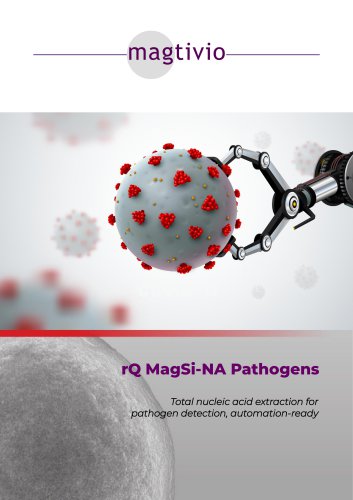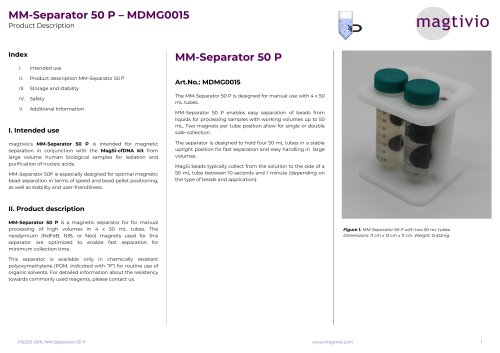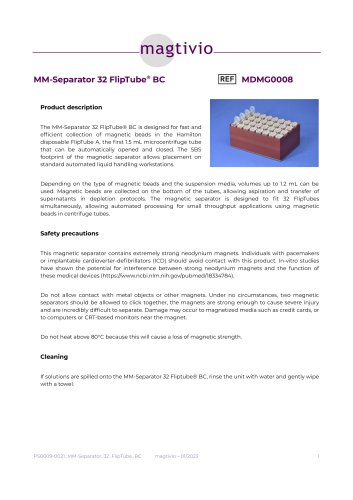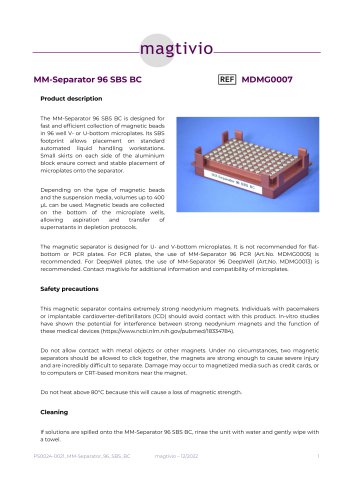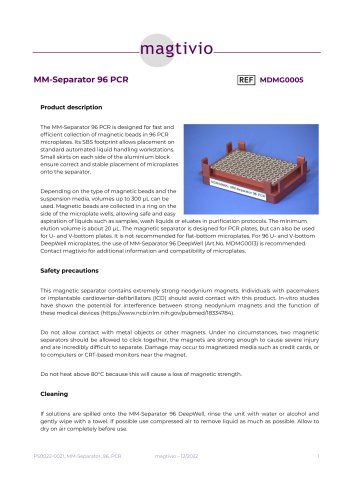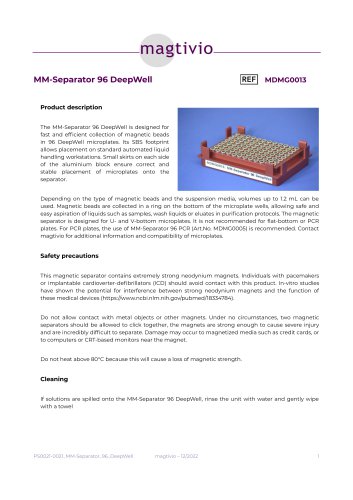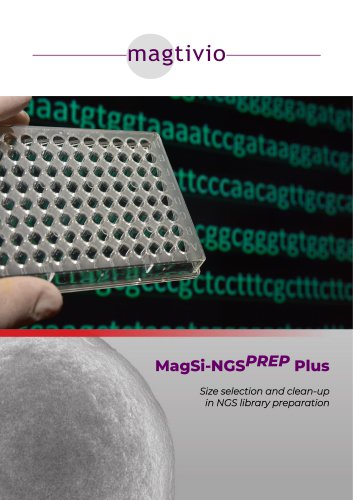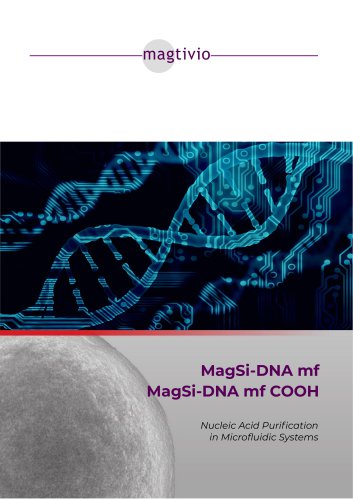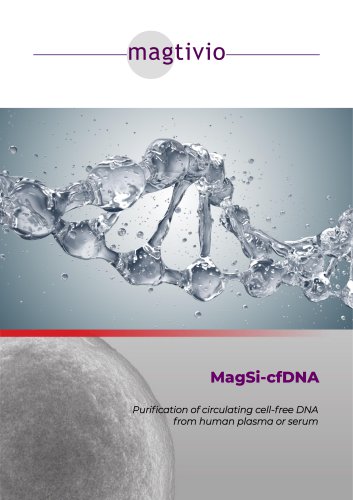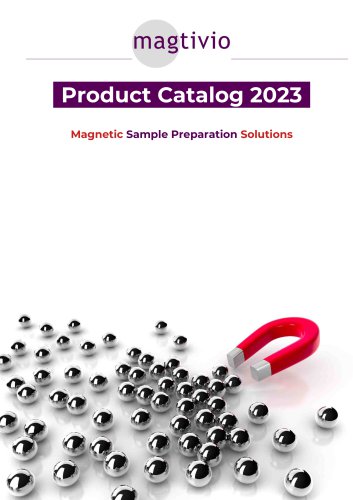
Catalog excerpts
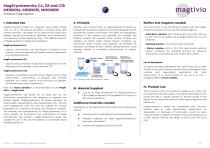
MagSi-proteomics C4, C8 and C18 MD0X014, MD0X015, MD0X009 Product DescriptionI. Intended Use II. Principle Buffers and reagents needed: peptides MagSi-proteomics beads are magnetic silica beads coated with C4, C8 or C18 groups, providing a reversed phase (RP) surface chemistry. The beads are an ideal tool for protein and peptide sample concentration, desalting and fractionation, and reducing sample complexity (Fig. 1). The different versions of MagSi-proteomics beads are intended for: MagSi-proteomics C4: • capture, concentration and purification of proteins from protein mixtures in general, cell lysates, culture supernatant (e.g. secreted proteins). MagSi-proteomics C8: • capture and purification of peptides and proteins from the following clinical samples: urine, saliva and CSF MagSi-proteomics C18: • Desalting of peptides or protein tryptic digest prior to mass spectrometry, concentration of peptides (e.g. secreted peptides into media), capture and purification of peptides and proteins from serum and plasma Note: For tissue samples it is recommended to use MagSi-WCX or MagSi-WAX. MagSi-proteomics C18 beads are an ideal tool for the purification, concentration and desalting of peptides and protein digests. MagSi-proteomics C8 beads represent an intermediate hydrophobicity (less hydrophobic than C18 and more hydrophobic than C4) and are suitable for sample preparation for proteomic profiling and biomarker research. The relatively low hydrophobicity of MagSi-proteomics C4 is most suitable for purification and fractionation of larger biomolecules like proteins. MagSi-proteomics beads are suitable for use in 96 well microplates on automated liquid handling platforms. Peptides and proteins bind to MagSi-proteomics beads via hydrophobic interactions between the protein/peptide and the hydrophobic surface of the beads. The higher the hydrophobic character of the proteins and peptides the stronger the binding towards the reversed phase surface. Proteins and peptides are eluted under organic solvent conditions, e.g. acetonitrile (ACN). Proteins and peptides can therefore be separated according to their relative hydrophobicities using stepwise elution in increasing concentrations of organic solvents. remove supernatant Desorption buffer C8 or MagSi-proteomics C18 (supplied at 10 mg/mL in 25% ethanol absolute) Additional materials needed: Depending on the application, some buffers and materials are needed: • Mixer/vortex to mix samples and resuspend beads • Magnetic separator for bead separation/collection (see order information) • Solvents and reagents like ACN and TFA We recommend to use the following buffers with the MagSi-proteomics beads and only use HPLC grade reagents. • Adsorption solution: 0.1% trifluoroacetic acid (TFA), NaCl up to 200 mM can be added using MagSi-proteomics C4 and C8 beads • Washing solution: 0.1% trifluoroacetic acid (TFA) • Elution solution: ACN in 0.1% TFA. User should optimize elution conditions for individual proteins by adjusting acetonitrile concentrations, such as 20%, 50% or 80%) Use of detergents: For better handling, detergents like 0.01% Tween 20 or 0.01% TX-100 can be used. However, please note that detergents may interfere with downstream applications like mass spectrometry. It is recommended to use up to 8 mM n-octylglucoside for serum analysis. IV. Product Use When stored at 2-8°C, this product is stable up to 2 years, but no longer than the expiry date on the label. Store beads in well closed vial and in upright position to prevent drying of the beads. Do not freeze the product! Vortex bead suspension well before use. MagSi-proteomics beads are compatible with common solvents used in mass spectrometry applications. No degradation or decrease of functionality could has been measured after incubation of beads in ACN concentrations up to 80%, several alcohols like MeOH or EtOH, and TFA up to 0.5%.
Open the catalog to page 1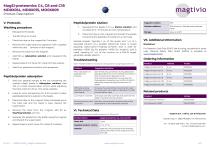
MagSi-proteomics C4, C8 and C18 MD0X014, MD0X015, MD0X009 Product Description V. Protocols Washing procedure • Resuspend the beads • Transfer 20 |jL to a tube • Place the tube on the magnet for 2 minutes. • Remove the supernatant by aspiration with a pipette while the tube remains on the magnet. • Remove the tube from the magnet. • Add 100 jL Adsorption solution and resuspend the beads. • Repeat steps 3 to 5 twice, for a total of three washes. • Add 10 jL adsorption solution and resuspend. 1. Add your peptide sample to the vial containing the washed MagSi beads in Adsorption solution. Add...
Open the catalog to page 2All Magtivio B.V. catalogs and technical brochures
-
rQ MagSi-NA Pathogens
2 Pages
-
MM-Separator 50 P
2 Pages
-
MM-Separator 32 FlipTube® BC
2 Pages
-
MM-Separator 96 SBS BC
2 Pages
-
MM-Separator 96 PCR
2 Pages
-
MM-Separator 96 DeepWell
2 Pages
-
SafeQ Saliva Collection Kit
2 Pages
-
MagSi-Tools 600, 1.0, 3.0
2 Pages
-
MagSi-STA 600, 1.0 and 3.0 L
2 Pages
-
MagSi-STA Trial kit
2 Pages
-
MagSi-NGSPREP Plus
2 Pages
-
MagSi-DNA Stool
2 Pages
-
MagSi-DNA FFPE
2 Pages
-
MagSi-cfDNA
2 Pages
-
MagSi-DNA Tissue & Cells
2 Pages
-
Product Catalog 2023
52 Pages


